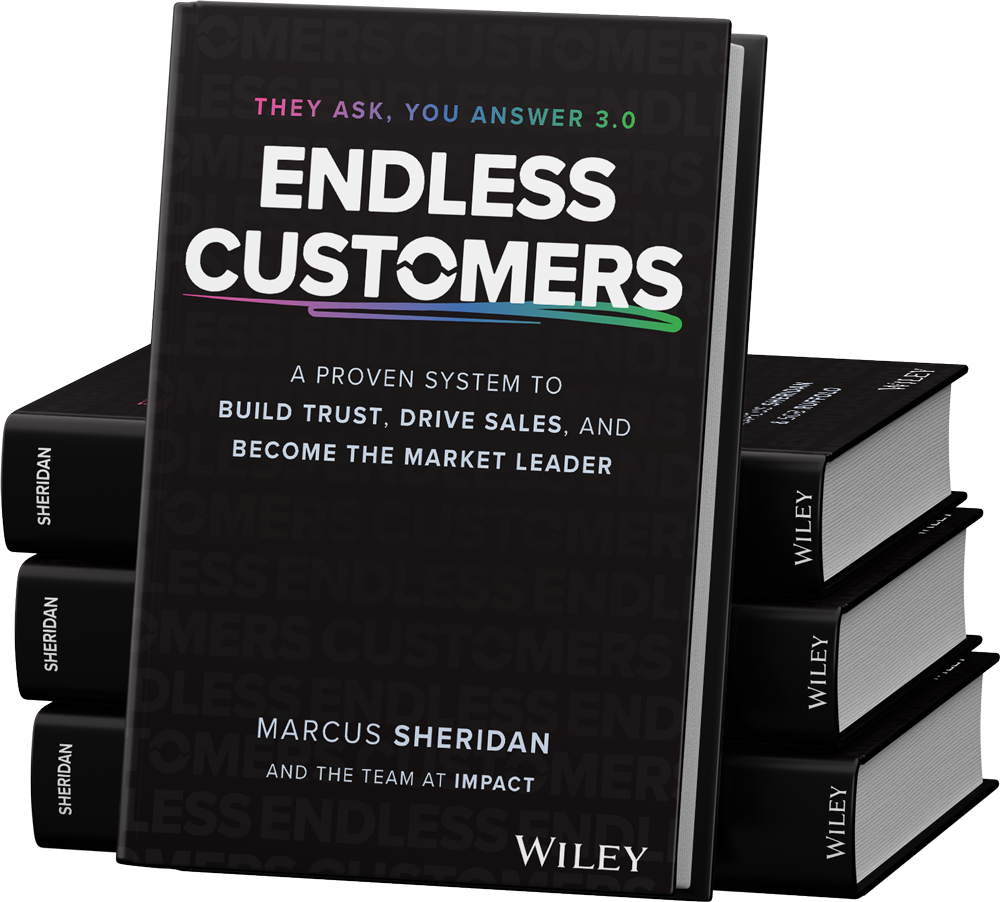Topics:
Endless CustomersSubscribe now and get the latest podcast releases delivered straight to your inbox.
The Endless Customers Game Plan is a shared tool your team builds and uses together to drive aligned action every 90 days. It brings your company’s strategy down to the ground, into real conversations and real outcomes.
If you’ve made the decision to bring Endless Customers into your organization, you’ve already taken a major step.
You’ve recognized that your buyers now expect clarity, transparency, and useful education throughout the decision-making process. You’re ready to step up and become the most trusted voice in your market.
We’ve seen what happens when teams align around a shared mission and commit to showing up consistently. The businesses that win are the ones that create a system for action, build internal ownership, and keep trust at the center of everything they do. If you’re willing to lead differently, the results are absolutely within reach.
That’s why the Game Plan matters.
In this article, we’ll break down what the Endless Customers Game Plan is, why it matters, who should own it, and how to use it to drive clarity, alignment, and consistent progress every quarter.
The Role of the Game Plan in Endless Customers
Endless Customers is built on four trust-building behaviors:
- Say what others in your space aren’t willing to say.
- Show what others in your space aren’t willing to show.
- Sell in a way others in your space aren’t willing to sell.
- Be more human than others in your space are willing to be.
The Scorecard helps you see how well your company is living those behaviors across sales, marketing, and leadership. The Game Plan takes that awareness and turns it into a focused 90-day execution strategy. One that your team can actually own.
Every 90 days, you use the Scorecard to identify your biggest gaps and clearest opportunities. Then you build your Game Plan to close those gaps with intention. You identify three to five Focus Areas that will drive meaningful progress toward your long-term goals and vision.
Who Should Own the Game Plan?
The Game Plan should not live with one department or sit with one person. If it does, it will fail.
Ownership belongs to a small cross-functional group. At a minimum, this includes the CEO, the head of marketing, the head of sales, your content manager, your videographer, and someone in a system owner role (often the Trust Champion).
This group is responsible for building the plan, communicating it to the wider team, and reporting on progress every quarter.
What a Real Game Plan Looks Like
Here’s how the structure works:
- Shared Vision
You start with a clear picture of what success looks like 18 to 24 months from now. These are specific, measurable business outcomes that reflect where you’re trying to go. - Current State
Next, you document where you are today. This includes metrics like lead volume, close rate, content output, sales process readiness, and team capacity. No filters. No spin. - Focus Areas
Then you define three to five areas that will get your team closer to the vision. Each Focus Area includes a desired outcome, a named owner, a deadline, and action steps with clear expectations.
Focus Areas might include launching a new website, creating 30 Big 5 articles, implementing Assignment Selling, building out a sales dashboard, or publishing two new videos per week.
- Metrics That Matter
You choose KPIs that reflect progress on your trust-building and revenue goals. These often include inbound SQLs, form fills, average deal size, publishing cadence, and sales cycle length. - Accountability Cadence
The plan is reviewed and updated every 90 days. Wins are celebrated. Gaps are addressed. Focus resets. Nothing drifts.
Why the Endless Customers Game Plan Works
It brings focus. It forces decisions. It sets a rhythm. And it gives your team permission to say, "Not now" to work that doesn't move the needle.
Teams that work from a Game Plan don’t get lost in busywork. They know exactly what matters, why it matters, and who owns it. Instead of reacting to issues as they come up, they are proactively building toward outcomes.
This clarity changes team culture. Over time, it sharpens execution and builds confidence.
Who Should Not Own It
The Game Plan doesn’t belong with a junior hire, an external partner, or anyone who can’t drive decisions. It’s strategic work that needs protection, visibility, and follow-through. If the person leading it can’t set priorities or keep things moving when business gets noisy, progress will stall.
It must be championed by decision-makers who can prioritize, resource, and protect the work.
Where to Go From Here
You don’t need to figure out the Game Plan on your own. In fact, some teams struggle when they try. They know the importance of alignment, but without structure, accountability, and outside perspective, the work gets pushed aside.
That’s where our Endless Customers Coaching & Training Program comes in. Your coach will guide your team through building its first 90-day Game Plan, step by step. Together, you’ll define the right Focus Areas, assign clear ownership, and set up a cadence that actually sticks.
When you work with a coach, you’re practicing the habits of high-trust companies: clarity, alignment, and consistency. And with every quarter, those habits compound into momentum your whole business can feel.


Order Your Copy of Marcus Sheridan's New Book — Endless Customers!

